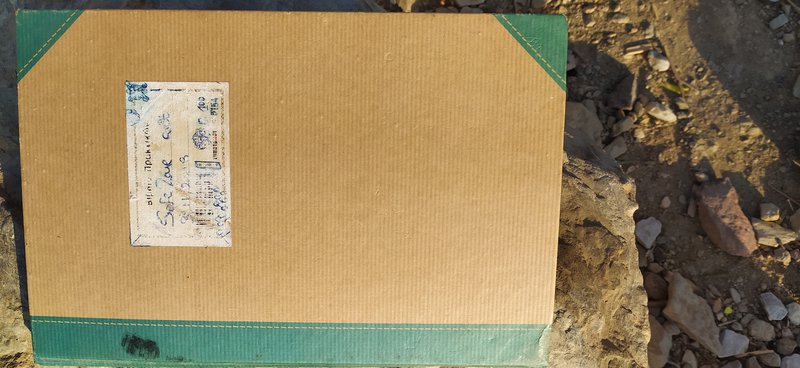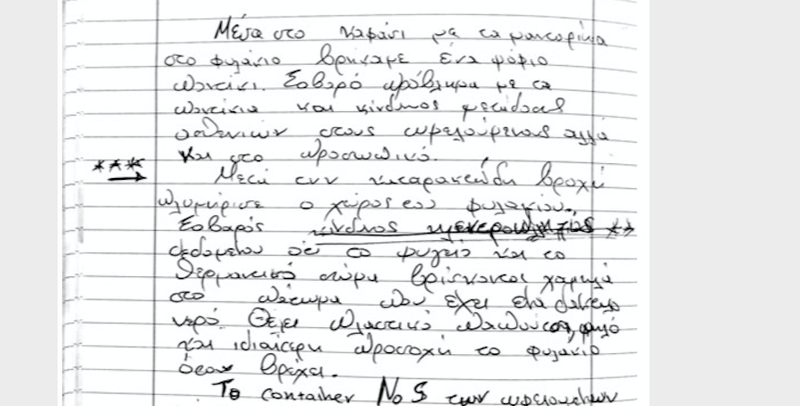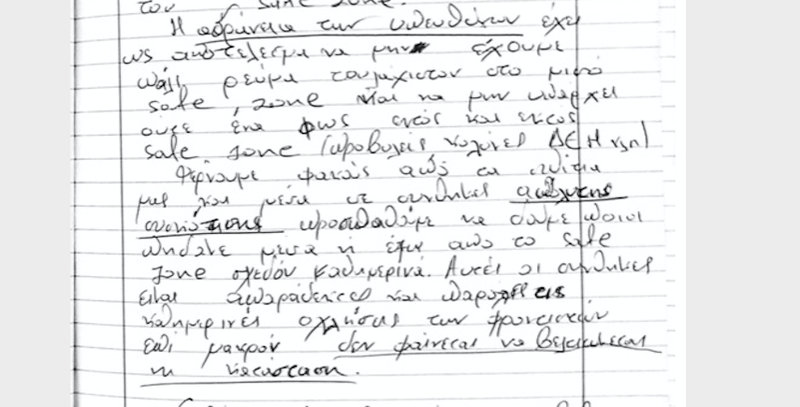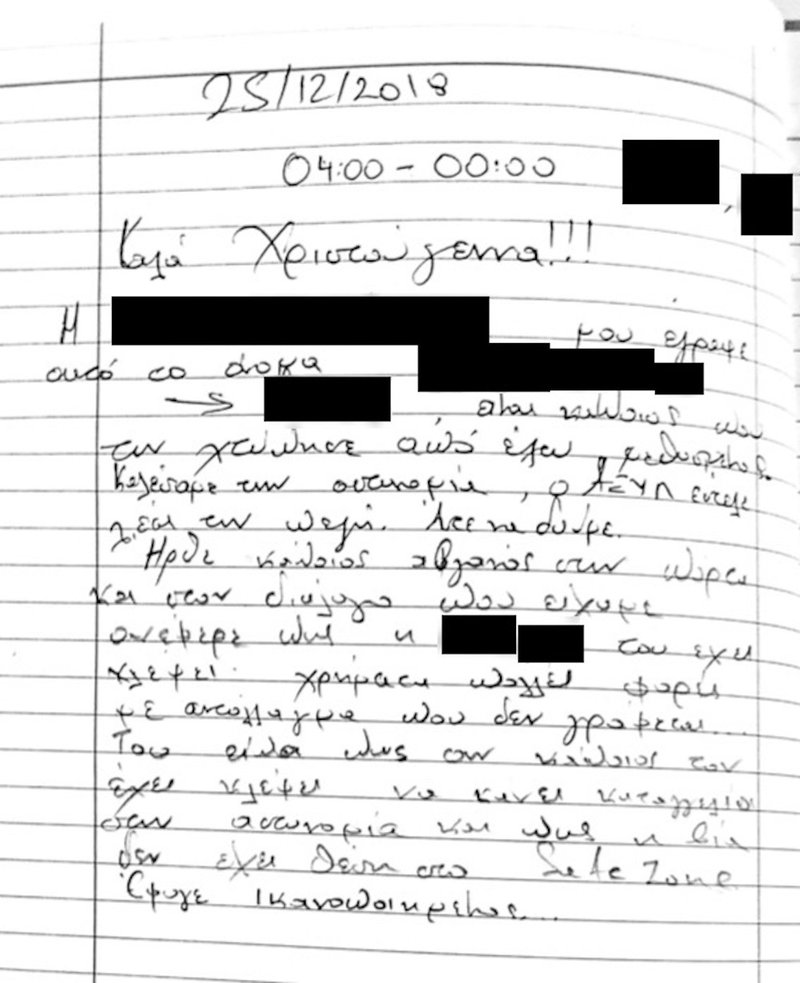In the ashes of Moria, Europe’s most notorious refugee camp on Lesbos, Investigate Europe reporters found a logbook that documents the horrors that unaccompanied minors in the camp had to endure. It appears to have been used by people who were there to protect the minors, but communicates a sense of helplessness in their ability to do so. The following account is based on excerpts from this logbook and provides a first-hand insight into Europe’s failure to protect the most vulnerable group of asylum seekers. Since the fires at Moria in September, the situation for minor migrants in the Greek island has only become worse.
 Logbook from Moria safe zone. | Stavros Malichudis. All rights reserved.
Logbook from Moria safe zone. | Stavros Malichudis. All rights reserved.It’s a cold November morning back in 2018, when care worker, Fanis*, working in Moria’s ‘Safe Zone’ makes a revolting discovery. On collecting a box of mandarin oranges for the children from the guardroom, he finds the contents are not only the oranges. The box also contains a dead rat.
This wasn’t the first time it had happened. “Serious problem with the rats and danger of infusion of diseases to the beneficiaries and the personnel,” he notes at the end of his shift, in the logbook entry dated 18 November.
And the rat was not his only concern that morning.
The torrential rain of the night before had flooded the guardroom – where the fridge and heating unit are located – then seeped into ‘Container No 5’, home to some of the camp’s unaccompanied minors. “Container No5 seeps some water on the inside. It needs insulation with silicone. Danger of electrocution” Fanis warns before putting his pen away and closing the book.
Day by day: Moria’s horrifying story
Until the evening of 8 September 2020 when multiple fires razed it to the ground, Moria had been Europe’s most notorious refugee camp, synonymous with dehumanizing and dangerous conditions.
Walking around the burnt periphery of the camp in the aftermath of the fire, through what was called the ‘jungle’ – once an olive grove encircling the structure on which hundreds of makeshift tents were set-up – one of the authors of this article, Greek reporter Stavros Malichudis, found the notebook. It was nestled in the ground, amid the ashes of destroyed tents, burnt possessions and the soot that dusts the area in black. The hardcover of the book helped it survive the fire. It covers a time span of roughly six months, from 3 November, 2018 to 7 May 2019.
Fanis wasn’t the only contributor to the logbook: it appears to be the day-to-day diary that was maintained by 11 employees from the “International Organization for Migration” (IOM), an intergovernmental organisation that is related to the United Nations and was responsible for the so called safe zone. The team consisted of “child protection workers, psychologists, lawyers, caregivers, nurse and interpreters to assist children and cover all their needs” according to the IOM. The safe zone was where unaccompanied minors lived under supervision, often for months, while they waited to be transferred to the Greek mainland or to other European countries. It was the zone where minors were supposed to live under better protection than in the rest of the camp.
Moria’s unsafe living conditions were reported extensively. In the winter of 2020, Investigate Europe – together with the Greek investigative network Reporters United – published an investigation about the detention of minor migrants in European countries. As part of this investigation, IE also reported about the unsafe conditions in Moria.
The logbook confirms the constant, never-ending technical inadequacies, the deep psychological struggles of the children, and the dangers awaiting them at every corner – not just outside the safe zone, but inside it as well.
The danger of electrocution, while a constant fear, was far from their only concern.
 Logbook, Moria
Logbook, MoriaDanger in the darkness
Power cuts – caused by heavy rainfall or other incidents – appear regularly in the 190 pages of the notebook. Sometimes the problem was not fixed for days.
An absence of electricity at night prevented staff from properly supervising the two sides of the barbed wire separating the safe zone from the rest of the camp. Seeing who entered or exited the safe zone was an important task; after all, it was the caretakers’ job to make sure the safe zone actually was safe.
On 24 November 2018, during a power shortage that had already lasted several days, one of the care workers – on shift were Fanis, Maria and Giannis – opens the notebook. The tone is desperate.
“The inaction of the people in charge is resulting again in us not having electricity, and not having even one light inside and outside of the safe zone,” the note says. “Almost daily, we bring torches from our houses, and in conditions of full darkness, we try to see who jumps inside and who jumps outside of the safe zone. These conditions are unacceptable, and no matter the daily complaints of the care workers for [so] long, the situation does not seem to be improving.”
The writers’ concerns were warranted. Anything could happen to minors who ventured outside the protected area.
 Logbook, Moria.
Logbook, Moria.A sad Christmas note…
At the top of the page “Merry Christmas!!!” in big, clear letters stands out among other notes that appear to be hastily written.
It is 25 December 2018, and a female minor from the safe zone – named S. – has just passed a piece of paper with a name on it to the social workers. It is the name of her abuser. The care workers jots down the name in the book in pencil among other notes made with a blue pen.
“He beat her outside of the safe zone while he was drunk,” the care workers add. “We called the police, the officer sent the walking patrol. Let’s see what will happen.” The entry is signed by Fanis and Dimitris in a resigned tone that indicates they don’t expect much action to be taken.
Earlier that day, in a separate incident, it was reported that a man had approached the entrance of the safe zone. He had accused the girl, S, of stealing money from him. The man had given her money on many instances, he claimed, “in exchange for things that can’t be described”.
The care workers had sent him away, telling him that if someone had stolen money from him, he should go to the police, and that violence has no place in the safe zone. “He left satisfied…” the notes say. It is not clear from the notebook if the incident had any consequences and if so what, and if the abused girl received any help. In general response to IE’s request for comment (they did not respond to questions specifically), IOM said that “psychological support to children to prevent or address any arising conflicts” was granted under their supervision.
Dozens of dangers
Sexual exploitation, as the above incident implied, was just one of the dozens of dangers that minors faced from the moment they entered the safe zone. Other common dangers were alcohol or drug abuse and getting involved in fights.
On the evening of 4 April 2019, male minor N. is reported to “have made inhalations of the liquid used to refill lighters, as usual, and started to act in a weird way”. After some time, he starts pelting stones at the containers, smashing windows. “The officer on shift was informed, they came quite quickly, but N. jumped off the fence and left,” states the entry.
There are numerous cases reported in the notebook, sometimes on consecutive days, describing minors who return to the safe zone drunk or stoned. Sometimes causing disturbances to residents and care workers, and engaging in altercations.
“Fuck Moria!”
There are times when the care workers appear to be unable to handle a situation and need to ask for the intervention of the police present in the camp to calm things down.
“We are still alive!!!” says a note signed by the care workers Dimitris and Iosif on the night of 6 December 2018. “As Q., H. and A. came back from outside, they were probably drunk (maybe even high) and insulted us by saying ‘fuck you, fuck police, Moria’ etc.”
The events of that particular night were not limited to just verbal insults. The notebook provides a detailed description of what happened before the police – after 40 minutes – finally managed to calm things down, eventually taking the three of the boys to the police station.
“It’s nice to be crazy,” the minor named Q. kept shouting at the care workers. His outburst left some damage in its wake: “There are 13 windows broken, we did not check the closets, but estimate three or four of them too, and rubbish bins are also among the broken items” was noted in the logbook.
Tensions among minors
It has previously been reported that the dire conditions in the Moria camp fuelled tensions between different ethnic and national groups. In early 2020, Investigate Europe and Reporters United published findings about the conditions endured by minor asylum seekers across the continent, including at Moria where “they stand in line. There are queues in front of the toilets. There are queues to shower, often in cold water ”, we wrote in our report. Swedish aid worker Patric Mansour, who had worked in Moria since the early days of the camp, told us that the high levels of stress and frustration were created by an everyday life that was governed by “delays in all areas”.
“All the frustration is placed on the individual, who lives in uncertainty,” he said. “There is violence and crime. People fight for little things because of stress.”
The notebook shows that even in the safe zone minors were affected by violence in the camp. Throughout the notebook, acts of violence are documented as part of everyday life: a fight among two boys leads to another getting involved, and finally ends with one of them being taken to the doctor (26 November 2018). Two brothers attack a third boy with sticks ( December 2, 2018).
Harsh reality of the safe zone
The violence didn’t always occur amongst groups – sometimes the minors directed it towards themselves and the logbook reports on incidences of self-harm. On 6 November 2018, the female minor S. – who would later report the abuse – harmed herself with a razor inside the girls’ showers and was taken to the doctor. The wound was deep, says the entry. On 8 March 2019, another female minor, mentioned as A., cut herself and was taken to the local hospital to be seen by a psychiatrist.
Other entries similarly highlight the psychological trauma experienced by the children in the camp.
Intervention by the camp’s military doctor was often required and in a number of cases minors had to be escorted to the island’s hospital. But even there they did not always receive the help they needed.
On the night of 1 December 2018, a baby who lived with her teenage mother in the girls’ section started crying. “We took [the baby] to the military doctor of the camp, but he told us that he has no expertise on babies and that someone should see it tomorrow,” the care worker writes, adding that the baby could possibly have chicken pox.
That night the safe zone once again experienced power shortages, leaving the sick baby, along with other minors, with no heating to protect them against the cold night.
 Logbook, Moria
Logbook, MoriaUnheeded warnings
The log of 7 December 2018, is somewhat longer than that of most days and includes two warnings, spread over two pages, once again from Fanis, the care worker on shift.
Following the events of the previous night, which required police intervention, he writes, “It is obvious that there is a great inactivity in the management and supervision of the section, despite our constant complaints and warnings. We will keep informing and working in unprecedented and unacceptable conditions, and let us all wish that there will not be more serious incidents with beneficiaries [minors in the safe zone] and colleagues.”
He goes on to add that ten more Afghan boys had been transferred to the safe zone the previous day and warns that transfers of this number could fuel tensions in the small community.
“The old ones feel that they need to prove something, and the newcomers feel the pressure of the new society in which they have entered. Transfers of beneficiaries should take place gradually, as their number as well as their nationality matter, otherwise events like that of yesterday will continue to overturn the reality of the safe zone,” he writes.
But this is not the only concern expressed by the care worker that day. Fanis notes that older boys, who have been involved in acts of violence in the past, can remain in the safe zone, causing anxiety for the care workers. The logbook chronicles encounters with them and warns of similar events happening in the future.
“At the least, it is problematic to see mothers with babies, unaccompanied young boys and criminal elements, even persons holding knives and makeshift weapons, living together for months in the same place. The role and the cause of existence for the safe zone needs to be redefined and this is a discussion that has to take place with no further delay,” the note concludes.
The logbook showed no indication of any reaction to these concerns by the authorities and the violence continues.
IOM in response to Investigate Europe stressed, that they worked “in close coordination and under the guidance of the Reception and Identification Centre (RIC)”, which means that the responsibilities for any major decisions did lie with the Greek authorities. The Greek Ministry of Migration and Asylum did not answer any of IE’s requests for comments.
On the last day of entry, 8 May 8, 2019, there were 4,752 people living in Moria, even though its capacity at the time was only 3,100. The safe zone had a capacity for about 150 unaccompanied minors, but in the time span of the notebook it housed between three and six hundred.
Three months after that last entry, on the night of 25 August 2019, just as the care workers had feared, violence erupted, and a 15-year-old boy from Afghanistan was stabbed to death in the safe zone.
The new camp: no provision for unaccompanied minors
Now that Moria has burnt to ashes – has the situation of the minor migrants improved?
In the aftermath of the fire, the 400 unaccompanied minors that were then living in the facility were transferred to the mainland, and are expected to be divided among ten EU countries that will host them. But there have since been new arrivals, whose fate remains unclear. There is a new camp, known to refugees and NGOs as “Moria 2.0”, which was built in the days following the fire on a former Greek Army shooting range.
Food is provided just once daily, and one month after the new camp was set up, there are still no showers. Residents told IE that they have to shower in the open, while parents bathe their children in the nearby sea.
Families live in tents which do not have beds, while up to 100 single males share big tents, sleeping on bunk beds. So far there is no area in which unaccompanied minors can live separated from the rest of the population. The Greek ministry did not respond to IE’s request for comment.
*The personnel signed the pages with their names – most of the time they use first names only, sometimes full names too. The care workers also referred to the minors by full names. Investigate Europe decided to publish only the initials of the minors and to change the names of the care workers to protect their privacy.
 Xmas page, logbook, Moria safe zone.
Xmas page, logbook, Moria safe zone.Background information
Verification:
Investigate Europe and its Greek publication partner Solomon used a variety of methods to determine the authenticity of the notebook. All sentences on quotes are attributed exactly as they were written by the care workers, and all parts where words are underlined indicates that the words were underlined by the care workers in the logbook.
Infobox: background on Moria, the “worst camp on Earth”
Co-funded by the European Union and Greece, Moria was first created in September 2013 as a “reception and identification centre” for asylum seekers reaching the island of Lesbos, Greece, from the Turkish shores. Migrants and refugees alike were installed in a former Greek military camp. In 2015 Moria became an official EU “hotspot”. Despite its official capacity of 2,330 people, at the time of the September 2020 fire, the camp hosted 12,500 people. A year earlier, at the end of 2019, there were nearly 16,000 people living in Moria and more than 18,000 on the island of Lesbos. Asylum seekers were blocked from accessing Greece’s mainland, as the EU’s agreement with Turkey (signed in 2016) was imposing a geographical restriction to migrants and refugees who had reached the Greek islands from Turkey. See more here.
That means there were hundreds of tents outside the official facility, creating what was referred to by everyone as “the jungle” – and where the notebook was found after the fires. In 2018 the field coordinator for Medecins Sans Frontieres (MSF) workers dubbed Moria “the worst refugee camp on Earth”.
The safe zone had a capacity of about 150 unaccompanied minors but in the timespan of the notebook (November 2018 – May 2019) there were 300-600 living there.
Around 7,500 refugees are now living officially in “Moria 2.0”, widely so-called due to the bad conditions. This new camp has no safe zone for unaccompanied minors.
PrintJuliet Ferguson Stavros Malichudis Iliana Papangeli | Radio Free (2020-11-02T12:00:47+00:00) Moria: diary of a nightmare. Retrieved from https://www.radiofree.org/2020/11/02/moria-diary-of-a-nightmare/
Please log in to upload a file.
There are no updates yet.
Click the Upload button above to add an update.